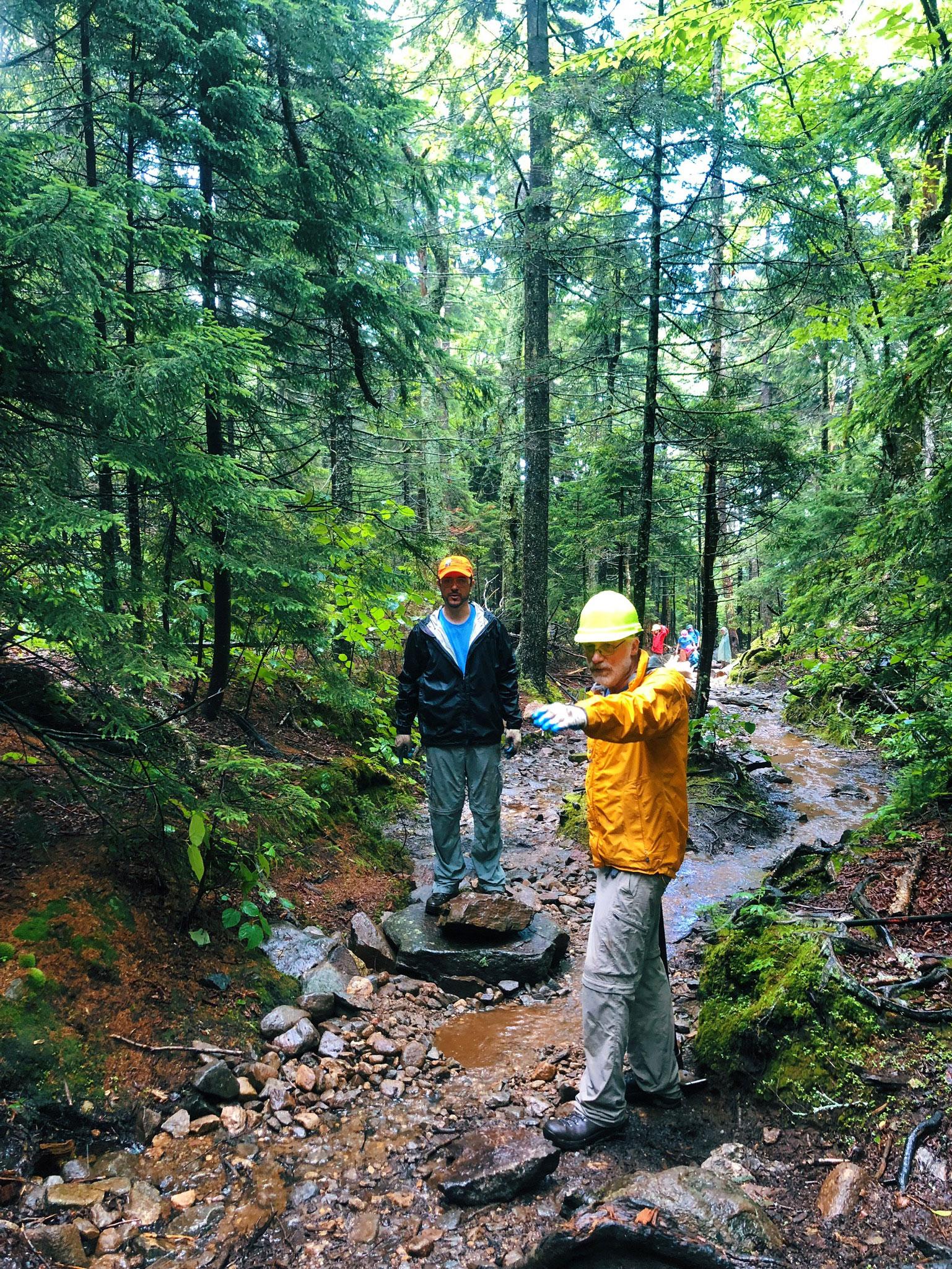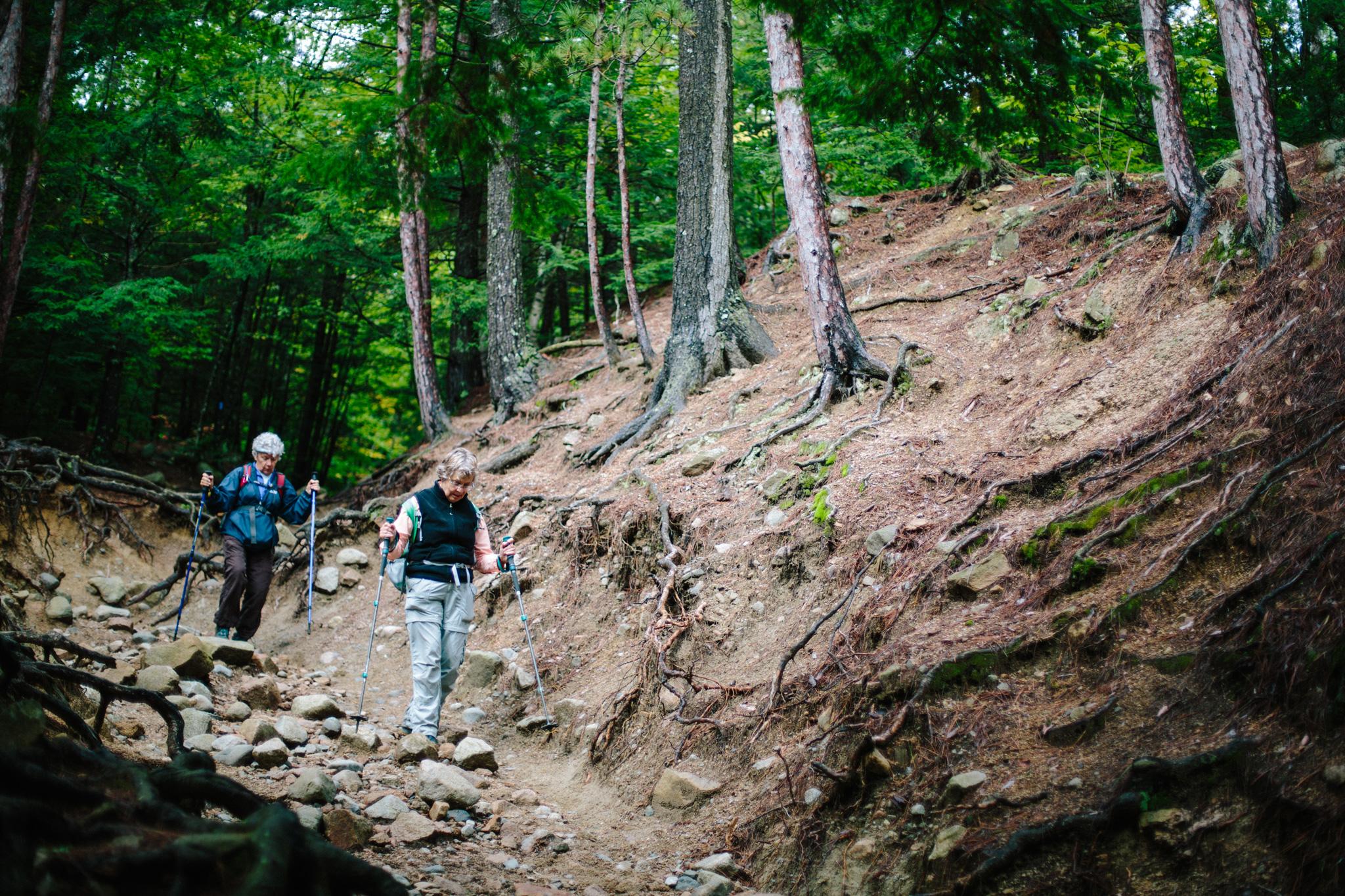- Tags:
- Clean Water,
- Climate,
- Recreation

Forest Society Forester Steve Junkin and Volunteer Dave Heuss strategize where to move rocks in order to divert water around a section of the White Arrow Trail at Mount Monadnock. Monadnock Trails Week runs through July 23. Emily Lord/Forest Society.
As a kid, I remember the joy of splashing in puddles. After the snow melted and spring rain filled the ditch by our house, I’d grab an inner tube and play like I was at the beach.
I’ve always loved summer thunderstorms, too. I’d press my face against our window screens so I could smell and hear the rain drops crash into the woods behind our house.

As an adult, my experience started to change. I remember May washouts delayed my return home from college in 2006. That was only a few months after a big flood hit southwestern New Hampshire in the fall.
I remember a severe thunderstorm in July 2008 which produced an EF-2 tornado that killed. I remember when Hurricane Irene swept away homes in 2011 and how an October 2017 storm destroyed trail and bridge infrastructure in the White Mountain National Forest.
Without our forests, the impacts from these storms could’ve been a lot worse. I recently spoke with Jason Cordeira, an Associate Professor of Meteorology at Plymouth State University, about rainfall in New Hampshire and our conversation turned to the role of forests.
Cordeira shared that forests can absorb up to 40% of rainfall, depending on the type of forest and rainfall. They are an essential filter and sponge that keep rivers from cresting and sediment and nutrients from flowing into our drinking water, recreational areas, and wildlife habitats.
According to the National Oceanic and Atmospheric Administration, precipitation has increased during the last century, with the highest number of extreme precipitation events occurring over the last decade.
Thanks to my conservationist predecessors who fought to stop logging in the White Mountains, water quality in the rivers and tributaries downstream have dramatically increased compared to a century ago.
While I splashed in puddles, organizations like the Forest Society were pivotal in keeping forests from being converted into parking lots and buildings.
I love all our natural resources have to offer. I swim at lake beaches, go hiking, and drink well water. I frequent scenic New Hampshire dirt roads to get off the beaten path. All of these joys are under threat because of our changing climate.
"The first effect of a warm atmosphere is that it holds more water,” said my friend and colleague, Will Broussard, Outreach Coordinator for the Mount Washington Observatory, when I called him to ask advice for this column.
This came up with I talked to Cordeira, too.
Here in New Hampshire, he explained, we get heavy rain in two ways.

Just earlier this month thunderstorms rolled through the state, dropping 4 inches of rain on towns in Grafton Country. Cordeira explained that’s a month’s average worth of rain in one day.
I remember this time last year when summer storms unleashed a deluge on Mount Monadnock in Jaffrey during the annual Monadnock Trails Week in partnership with the Forest Society and NH State Parks. Staff and volunteers hastened to complete trail improvement projects and divert a trails week record 2.46 inches of rain as best they could.
Even though conservationists protected 2,000 acres of forest through the Monadnock Reservation, its many trails create a path of least resistance for water. To keep hikers’ feet dry and improve safety and longevity of the trail surface, water bars and bog bridges were employed.
However, there’s little trail maintainers can do when the rocky trail becomes a literal waterfall. In the most extreme cases, closing, rerouting, or re-engineering steep New Hampshire trails might be the best option.
The Forest Society is working with a broad coalition of stakeholders on a long-term stewardship plan that will help protect natural resources at another popular hike, the Forest Society’s Mount Major Reservation in Alton. A part of the plan includes restoring the severely eroded trails to reduce soil erosion and protect water quality.

We have already hit the ground running this spring by contracting with a consultant who is assessing and developing plans for trail restoration, with the expectation to implement this plan over the next few years.
With precipitation on the rise, land managers across the state will need to seriously invest in upgrading our trail systems.
If you’re like me and you love what makes New Hampshire New Hampshire, consider joining your local conservation organization or donating to stewardship efforts like the Mount Major Stewardship Fund.
Emily Lord manages the Society for the Protection of New Hampshire Forests’ online and social media presence. Forest Journal runs every other week in the New Hampshire Sunday News. Reach Emily at elord@forestsociety.org or @forestsociety on Instagram/Facebook.
